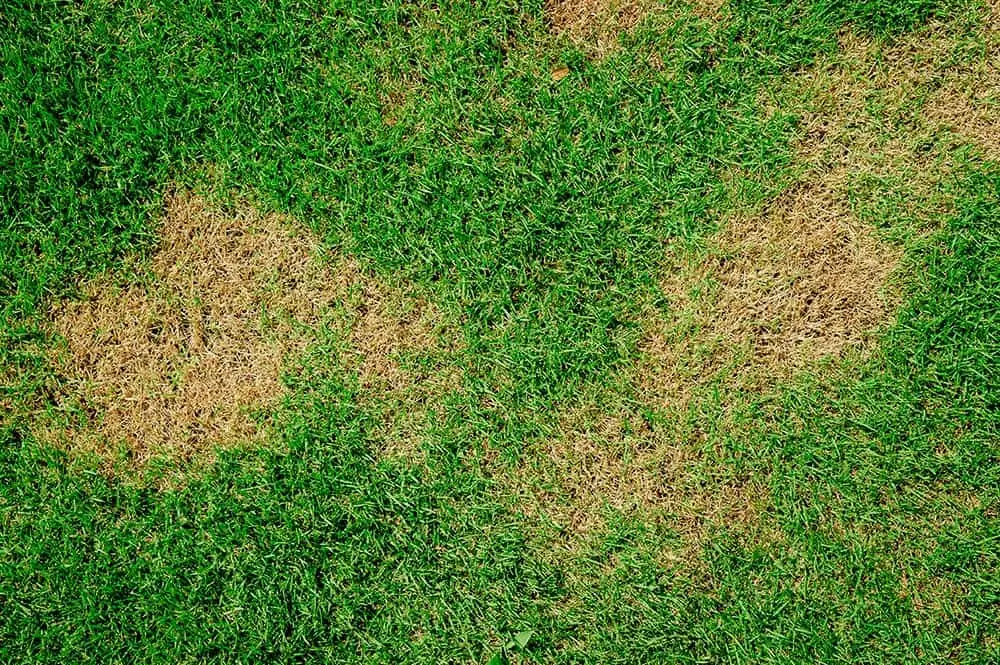The grass always seems greener on the other side. But when no matter what you do, pesky brown spots tarnish your beautiful lawn, it can be incredibly frustrating.
Typically referred to as blight, “grease spots” or to give it its proper name, Pythium Blight, these irritating patches have been present in the US for almost a century, after countless golfing greens began to fall victim to their presence in the 1930s.

Not only does it give your grass a sad-looking brown tinge, but it might also look visibly slick or oily, as well as being wet to the touch. If left untreated, unsightly white mold can begin to grow – yuck!
So, if you’re sick of fighting this ugly problem, let’s talk about what the root of your issue is, and how to solve it for good.
What Causes Pythium Blight?
Spread from plant to plant as mold spores form and disperse, pythium disease is caused by lingering bacteria in your soil, which may have been thriving down there for years – it’s hard to get rid of, and can resurface even when it seems dead.
Known to thrive in especially hot or humid weather and climates, you’re more likely to be susceptible to Pythium Blight when daily temperatures are hitting between 80 and 95 degrees Fahrenheit on a regular basis.
That being said, even when it’s colder and there is continuous rainfall, Pythium can still thrive: it’s just more likely to appear during what’s known as the “150 rule” when adding up temps for the day and night gives 150+ degrees Fahrenheit.
Slowly infecting leaves or grass one single blade at a time, it will appear in distinctive circular patches, often with trails leading away as a result of foot traffic, lawnmowers, or other vehicles dragging water that contains the mold spores across your lawn.
Areas with soil that is especially rich in nitrogen, where plants grow lush and free, are also more likely to be susceptible to Pythium; likewise, alkaline soles or those lacking in calcium can also be more easily affected.
How Do I Fix Brown Spots On My Lawn?
There are two approaches you can take to dealing with Pythium Blight: a more natural, cultural control, or one that involves chemicals. Using the former first and the latter as a last resort tends to be the best thing to do for the other plants in your yard.
Cultural Control involves making changes to the environment where your lawn is growing, in order to minimize or completely eliminate the factors that cause the mold to form, spread and thrive.
Areas of importance are air circulation, a balance in soil fertility and adequate drainage, especially when the weather is hot and humid. Taking the following steps will cultivate an environment that won’t hinder your lawn, but will stop mold growth:
- Try and get rid of any dew from your lawn in the mornings – there are a few ways you can do this, but the easiest is to mow the grass, dry it off hairdryer style with a leaf blower, or if all else fails, pulling a hosepipe taut and dragging it across your lawn (gently, being careful not to break any blades!)
- If you have a large concentration of trees and shrubs in a smaller area of land, this can reduce air circulation – cut a couple down to ensure that you’re achieving adequate aeration of your lawn, as this will help with drainage of water and also relieve any compaction you’re experiencing
- Stay away from aggressive irrigation, as these methods tend to leave the grass blades moist and humid for long periods of time, which as we have discovered causes those brown patches to thrive
- Say away from quick-release fertilizers, as these can increase the amount of nitrogen in your soil drastically – stick to those that offer a slow release of ammonium.
- Struggling with alkali soil? When the pH levels are above 6.5, then you can acidify its contents by using a product containing ammonium sulfate (but don’t use too much!)
Chemical Control, as the name suggests, requires the use of stronger fungicides in order to conquer Pythium Blight – this should be avoided where possible, but if your problem is severe, it might be your only option bar ripping up the whole lawn.
When you’re expecting a bout of hot, humid weather, applying fungicide as soon as you start to notice those brown patches appearing is crucial: waiting too long can result in the problem spreading further.
You can also apply some preventative fungicide if you tend to experience gratuitous Pythium Blight, as this can stop it from appearing altogether. Be sure to read the directions carefully and only apply as much of it as you need, and only where it is required.

